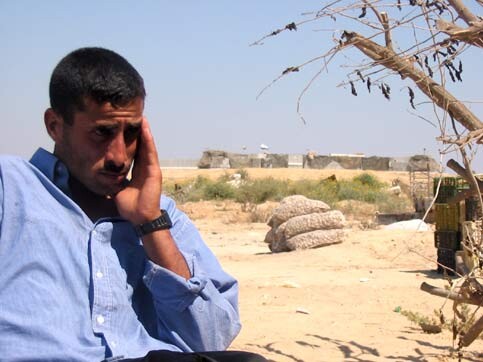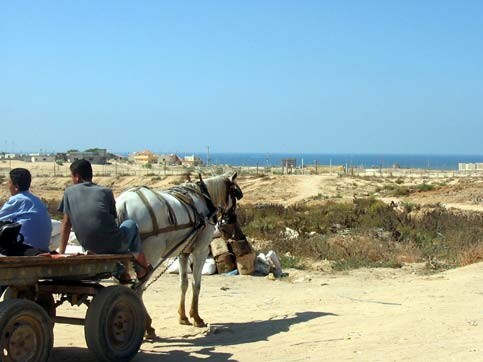
A member of the Al-Sayafa Bedouin community visits with us near his home under the constant watch of the Israeli occupying forces who inhabit this base, Seconds after this picture was taken, Israeli soldiers in the base fired in our direction. (Jacob Pace)
3 October 2003 — We were sitting outside a small shack at the edge of a Bedouin community in the Northern Gaza Strip region of Al-Sayafa. Abu Housa, one of the Bedouin elders, sat with us speaking in quick, expressive Arabic phrases, spreading his arms and flinging his hands about, the gestures adding emotional context to words that, for the most part, I could not understand. When we first arrived at the community we were quickly invited to sit in the shade of the shack and offered tea, as is customary here. There were five of us visitors — myself, another international worker, two other staff members from our organization (the Palestinian Centre for Human Rights), and our taxi driver from Gaza City.
As we interviewed Abu Housa, we sat with our backs to the shack and gazed directly across a small depression at a massive Israeli army base about 150 meters in front of us. On our left, to the West, the dirt track fell away to an electrified gate at the bottom of the hill, again, about 150 meters away. The gate is the only entrance in a fence that runs north-east from the illegal Israeli settlement of Dugit, south of the gate. The fence cuts across Palestinian land, eventually reaching Nissanit, another illegal Israeli settlement in the center of Gaza’s northern border.
The land around us was dry and bare. To the everyday observer it would appear to be an extension of coastal sand dunes, barren and inhospitable. However, this area used to be one of the most fertile in Northern Gaza. Strawberries and other crops once covered the rolling hills. In fact, Al-Sayafa was home to a successful agricultural development project during the Egyptian occupation of Gaza from 1948-1967. The Palestinian refugees who came here sought to rebuild their lives after they were forced to flee their homes in what is now Israel (see www.palestineremembered.com or www.alnakba.org). However, since Israel took control of Gaza in 1967, life in Al-Sayafa has become increasingly difficult.
Part of Al-Sayafa’s land has been confiscated by Israel and used to establish two illegal Israeli settlements. The first, Eli Sinai, was founded in 1982 and encroaches on Palestinian land in the Northwest corner of the Gaza Strip. Directly south (about 3 km.) is Dugit, founded in 1992. The area between these two settlements is owned and populated solely by Palestinians but has been under direct Israeli military rule since 1967. Recently, the Israeli occupation authorities began a massive land clearing campaign throughout the Gaza Strip. The campaign began immediately following the eruption of the current intifada in October, 2000. At first, enormous armored Caterpillar bulldozers began to raze areas near the borders, around illegal Israeli settlements, and in other strategic locations. However, as the Intifada reaches its third anniversary, the bulldozers continue to push further into Palestinian land, leaving man-made desert and crushed houses in their wake. (In the latest example, Israeli bulldozers demolished 18 homes in Rafah on October 1; see http://www.pchrgaza.org/)
We were in Al-Sayafa to collect information on the land clearing and the effects of the fence I spoke of earlier. The cumulative effects of the razing, the fence, the illegal settlements, and the massive Israeli military presence, have left the rural population of the area in ruins. The entire area comprises 8000 dunums (1 dunum is equal to 1000 square meters) and almost 90% of the land (over 7000 dunums) has been razed by Israeli bulldozers. The settlements have also grown exponentially- over 300 dunums have been illegally annexed to Dugit and Eli Sinai’s territory has expanded onto an additional 200 dunums of Palestinian land. Israeli occupation forces have also demolished at least 38 houses, 58 greenhouses and 36 other buildings in addition to destroying at least 38 wells and 28 irrigation networks. About 4000 dunums of Palestinian land is cut-off by the fence. 190 people live inside this fenced area and less than 500 dunums of agricultural land remain. Every resident of Al-Sayafa has suffered, but those inside the fence are submitted to incredible restrictions and harassment on a daily basis.
The residents of Al-Sayafa are trapped between the two settlements, the sea, and the fence. The one gate to the outside is only open twice a day for two hours- once at 8 am and once at 5 pm. Everyone has to wait. Children are always late to school (the day starts at 7 am in Palestine) and adults are always late to work (if they are not among the 60-70% of Gaza’s workforce that are unemployed). And this is on a good day, when the Israeli soldiers controlling the gate decide to let them through on time.

Children wait for Israeli soldiers to open the gate in the fence built by Israeli occupying forces to cut-off a portion of Al-Sayafa. The gate is only open twice a day for a maximum of two hours. On the left is the illegal Israeli settlement of Dugit. The entire area of Al-Sayafa was once prime agricultural land, more than 80% of the land has now been razed by Israeli bulldozers. (Jacob Pace)
In the evening, the soldiers often close the gate early, locking out those who are not immediately present. Only residents are allowed through the gate, no visitors can enter Economically, the Israeli policy is even more catastrophic. The few Sayafa farmers whose land has escaped the bulldozer find it incredibly difficult to transfer their goods to the market. Only one truck-load of produce is allowed out per week. Residents explained that the gate was closed last week and the truck was stuck inside while its load of fruit rotted. If the truck is not allowed through, farmers are forced to take their produce on donkey carts. The carts are not as efficient as the truck and carry far less produce. Also, only a limited number of carts are allowed access to the area. They are licensed and registered by the Israeli occupying forces. All cars are denied entry.
There are no services inside the fence- no schools, no clinics and little reliable electricity. To make matters worse, international aid agencies have ignored the area. No UN personnel have visited Al-Sayafa in the last two years and a plea by the mukhtar (village elder), Abu Ziad, for the United Nations refugee relief agency (UNWRA) to send a school bus to help the children reach school sooner have gone unanswered. In many ways, the isolation of Al-Sayafa mirrors the isolation of the Gaza Strip. In fact, many aspects of the situation in Al-Sayafa seem to be reflected in the Strip as a whole.
Throughout Gaza, the Israeli land razing project has chewed up tens of thousands of dunums of Palestinian land, left thousands of people homeless, and destroyed significant portions of Palestinian civilian infrastructure. Land is already a rare and valuable commodity in Gaza (a place that has one of the highest population densities in the entire world) and now giant swaths have been depopulated and devegetated. Gaza’s already weak agricultural sector has been hit the hardest and considering the massive cost of repairing damaged land, agriculture will surely have trouble recovering. As a result, the De-development of Gaza’s economy has quickly accelerated since the Israeli occupation forces began razing land.
However, the land clearing project is not simply aimed at crippling Gaza’s economy. Neither is it purely an environmental catastrophe. In fact, the effects of the land razing more closely resemble the effects of the separation wall Israel is building in the West Bank. Like the West Bank wall, the razings give Israel control over Palestinian land. In fact, as in Al-Sayafa, some of the razed land has already been incorporated into pre-existing illegal Israeli settlements. Other areas have simply been fenced off or otherwise separated from populated areas. Practically all the razed land in Gaza is guarded by Israeli soldiers- Palestinians who venture into these areas are shot on site. (For more on Israel’s separation barrier in the West Bank see http://stopthewall.org/).
As we sat, visiting with Abu Housa at the Bedouin community in Al-Sayafa, it was impossible to ignore the presence of Israeli soldiers only 150 meters in front of us. We couldn’t see their faces inside the giant structure of cement and camouflage netting, but we knew they could see us. As we sat in the shade the flow of our conversation was shattered by the pop of several gunshots from the base. We stopped and waited- it is common for the soldiers to harass Palestinians by shooting in their direction and our hosts were calm. A few more seconds passed while Abu Housa telephoned his family to make sure everybody was OK, then another volley of shots shattered the silence. This time we heard a couple of the bullets whistle past in the air above. We decided to move inside the shack to finish our tea and resume the interview.
The experience was slightly unnerving, although not frightening. The fact is that if the soldiers had wanted to shoot us, they would have. They were simply warning us- reminding us that they controlled this territory. It was the vulnerability of the situation that was new to me. But it is this vulnerability that I am growing used to in Gaza. Whether the danger comes from helicopter gunships over Gaza City, hilltop army bases, or sniper towers inside illegal Israeli settlements, Gazans live in a constant state of vulnerability. In the razed and ravaged areas of the Gaza Strip, the danger is even more apparent. Here Israel is in control. It is this authority that forms a basis for the expansion of the occupation. Israeli policies are not uniform across the Occupied Palestinian Territories, but everywhere control is key. Whether it is the wall, the bulldozer, or the sniper, the effects are always the same. As more Palestinians are forced out of their homes and off their land, Israeli control extends over ever greater portions of Palestinian territory.
Jacob Pace is an American activist working with the Palestinian Centre for Human Rights in Gaza City. He recently graduated from the University of California, Santa Cruz where he was active in “Al-Takaatuf: The Committee for Justice in Palestine”, among other organizations.

